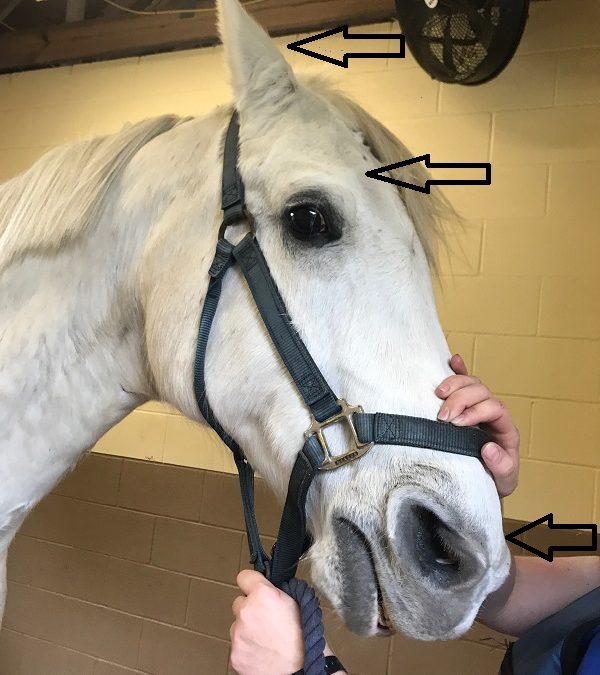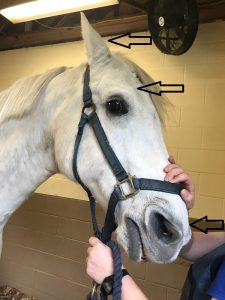Sometimes, in between cat naps, I pay attention to what medications you humans are picking up at the front desk. Names like ‘Bute’ ‘Banamine’ and ‘Equioxx’ have become pretty familiar to me. So this week I asked the docs what some of these frequently used medications were for. They explained to me that these are all different drugs used to manage pain in horses. Their explanation was fascinating. I never knew how much was involved in choosing the right drugs to control a horse’s pain!
The ideal pain medication would be one that worked great, lasted all day, had zero side effects, and cost next to nothing. Unfortunately, this medication does not yet exist. So, we have to compromise somewhere. You are either going to have to pay a little more for a medication that has fewer side effects, be willing to administer doses more frequently- up to every few hours, or choose the cheapest option, realizing it has a downside.
NSAIDs
When you think about managing pain in horses, Bute (generic for phenylbutazone) or Banamine (generic for flunixin meglumine) is probably the first drug to come to mind. These medications both fall into the category of NSAIDs, or non-steroidal anti-inflammatories. As the name implies, they are great at knocking out inflammation anywhere in the body. They also come in an easy-to-administer paste formulation, and they will keep working anywhere from 12 to 24 hours, which is super convenient. These drugs are both relatively inexpensive, with Bute being slightly more affordable than Banamine.
The downside to Bute and Banamine, however, is the side effects. When given at a full dose for more than a few days, both of these drugs are notorious for causing right dorsal colitis, stomach ulcers, kidney damage, and liver damage. Right dorsal colitis is the most common and arguably the most serious of these side effects. This is an inflammatory condition of the large intestine which results in diarrhea, malabsorption of nutrients, ulceration, and leakage of GI contents. The condition is difficult to treat, can be life threatening, and often leaves the colon permanently damaged.
NSAIDs cause right dorsal colitis and stomach ulcers because they knock out these little guys called prostaglandins. There are a couple different types. Several of them are inflammatory prostaglandins. When Bute and Banamine block these prostaglandins, it makes horses feel better. Other prostaglandins are involved in keeping the gut happy. When Bute and Banamine block these ‘good’ prostaglandins, you see the GI side effects described above.
Now there is a newer NSAID which recently became available for horses called Equioxx. Equioxx is a COX-selective NSAID, which means it blocks the inflammatory prostaglandins without blocking the good ones. Equioxx is also super cool because it lasts so long- a good 24 hours- and it’s easy to give in the form of one tiny, tasteless pill. The disadvantage of Equioxx is that it is a fair bit more expensive than Bute, and anecdotally it doesn’t control pain quite as well as the other good old NSAIDs. However, if you have a horse with a history of GI ulcers or colitis, Equioxx is definitely your best bet.
While NSAIDs will probably always be the first line of pain management in horses, it is important to understand the associated risks and always follow your veterinarian’s instructions when using these potent medications.
Steroids
As the name non-steroidal anti-inflammatory would imply, another class of anti-inflammatories is steroids, which is short for corticosteroids. The steroids most commonly used in equine medicine are Dexamethasone, Prednisolone, and Depo-Medrol.
Steroids are the most potent anti-inflammatory medication that exists, but they have effects on just about every organ system in the body. Steroids are actually produced endogenously (that’s a fancy doctor word that means inside the body) all the time. They play a role in several normal day-to-day functions.
Steroids are very cheap, and the docs prescribe them regularly for primary inflammatory conditions such as equine asthma and skin allergies. Steroids are also used in joint injections to decrease the inflammation caused by arthritis. However, steroids are not the greatest at analgesia (another fancy doctor word which means the reduction of pain).
Likely the biggest reason vets are hesitant to reach for steroids as a way to control pain is because of their #1 scariest side effect in horses: laminitis, or founder. For many equine practitioners, the risk of laminitis outweighs any potential benefit of reducing pain that steroids may provide.
The Others
So you know you can’t use Bute or Banamine for too long, or you risk blowing out your horse’s gut. You know you don’t want to use steroids because your horse could founder. Your horse is on a full dose of Equioxx at $2/day, but he’s still in pain. What else can you use?
This is the point where vets start thinking outside the box, and using what’s called multi-modal therapy to manage pain in horses. While NSAIDs target inflammatory pathways, there are other pain pathways, such as nerve pathways, that can be targeted as well.
Gabapentin is a neuro-modulating drug used as an anti-seizure medication in humans. It can be added to a vet’s pain control protocol to target the deep nerve pain associated with certain excruciating conditions in horses. Gabapentin is starting to get into big bucks, however, and it doesn’t seem to work well in some horses. Also, because horses have such a fast metabolism, it needs to be given every 8 hours to stay at therapeutic levels in the body.
Another option for pain control often used (and abused) in the human world is opioids. Tramadol, an opioid that has been studied and used in horses, has been criticized in the veterinary world as not working well to actually control pain, but primarily causing sedation. It seems that while Tramadol is a miracle drug for some horses with chronic pain conditions, it doesn’t make much of a difference for others. In addition to the obvious drawback that it is a controlled and closely regulated drug in the United States, another disadvantage to Tramadol is that it doesn’t last very long in horses. Studies have shown that the half-life of Tramadol is only about 3 hours, meaning that 3 hours after administration, half of the Tramadol has already been filtered out of the bloodstream, and by 6 hours it is nearly all gone. Who has time to medicate their horses every 6 hours? Not this cat!
It may seem simple, but a medication that has recently started to be investigated in horses is Tylenol. Yep, the same Tylenol you can buy at your local pharmacy. Since it hasn’t been used much in horses, not much is known about Tylenol’s potential side effects, but early results suggest it is relatively safe. Now, you may think Tylenol is a cheap alternative, but consider that you will be going through about 1 giant bottle of extra-strength Tylenol every 3 days to treat an animal as big as a horse, so the cost does add up. Based on preliminary research, Tylenol doesn’t seem to be potent enough to control pain in horses when used by itself, but it is a promising drug that can be added to your horse’s pain management therapy.
Well, there you have it: everything you ever wanted to know about pain control in horses. But don’t take my word for it. If you have any questions about managing your horse’s pain, I can think of 3 excellent humans who also happen to be veterinarians that would be happy to answer them.
Until next week,
Tony
P.S. So the humans did a podcast on this topic. If you want to hear it
Straight from the Horse Doctor’s Mouth, she does a pretty good job of explaining things. Well, for a human, anyway. You can listen right here on my website, or wherever you get your podcasts.



 Facial Expression
Facial Expression 